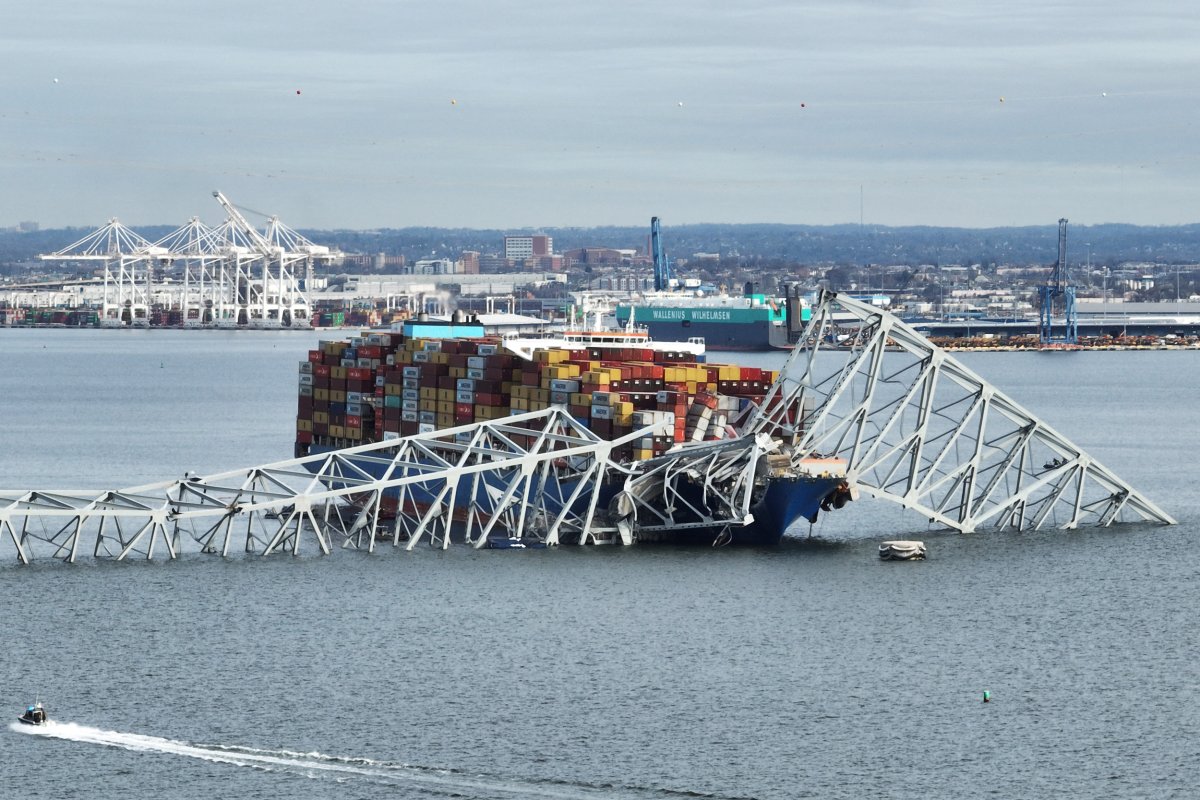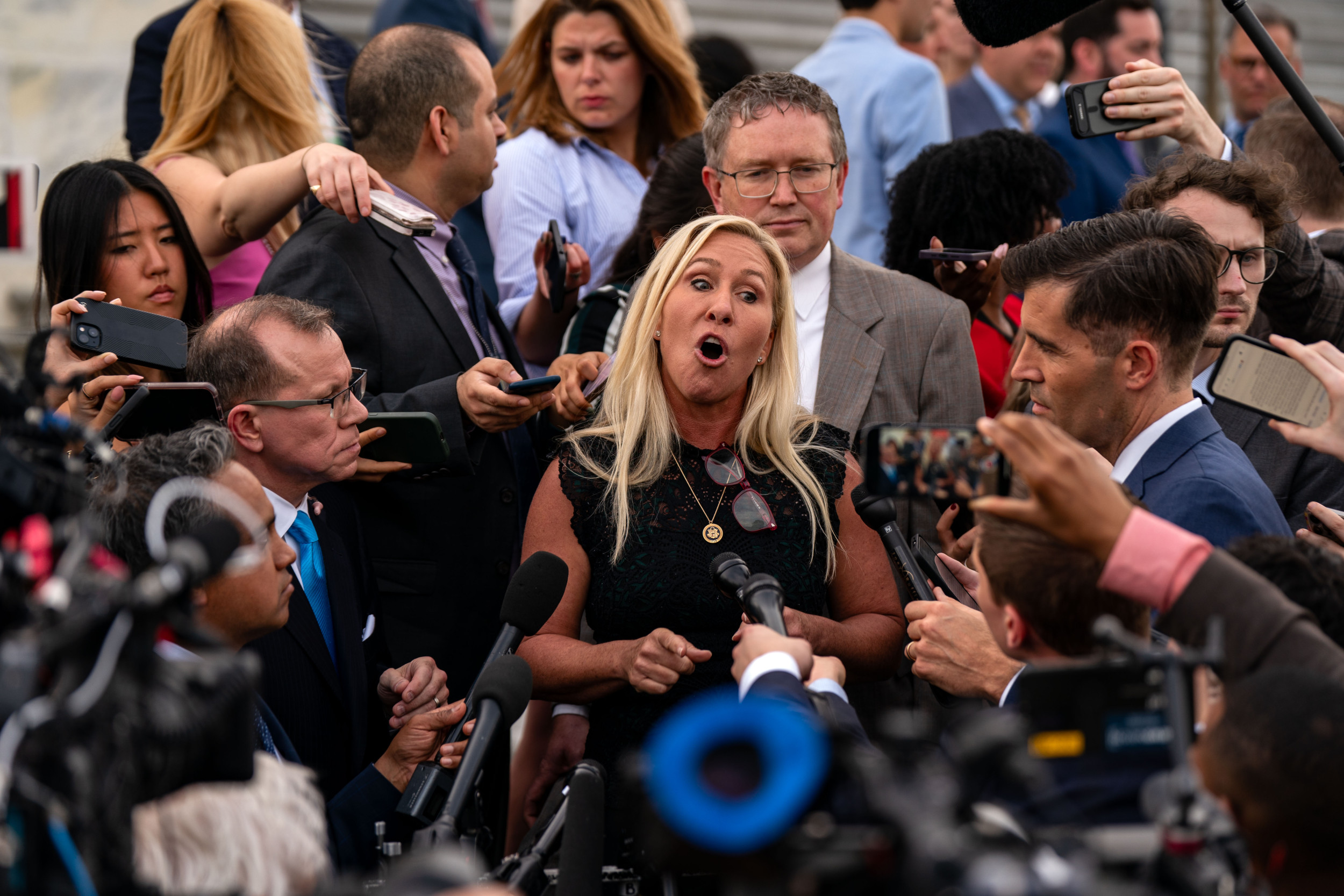The collapse of the Francis Scott Key bridge in Baltimore on Tuesday morning has sparked debate on whether certain protective systems could have prevented the disaster.
The Dali, a nearly 1,000-foot-long container ship, hit one of the bridge support columns at around 1:30 a.m., causing the entire structure to snap apart in several places and fall into the river, as seen in a video posted on X (formerly Twitter).
Emergency services have been searching for at least seven people, and authorities have referred to the situation as a "dire emergency." The Maryland Transportation Authority has urged motorists to avoid the bridge, which is part of Interstate 695.
Newsweek has reached out to Synergy Marine Group, the Dali's management company, by email for comment.

It is unclear why the ship struck the bridge, but the disastrous outcome has sparked debate among engineers and laypeople about the use of protective systems, such as fenders or dolphins to protect vulnerable bridge supports. Dolphins are protective objects—sometimes equipped with their own fender system—designed to protect a structure from impact from a marine vessel.
Some people have even argued that the city of Baltimore should be held accountable for the disaster given the bridge's design, but civil engineer and social media user @ConcreteKeenan countered the claim.
"Hi! Bridge Engineer here, no bridge in the world is designed to have a giant cargo ship the size of the bridge itself hit one of its main structural members dead on. Hope this helps!" @ConcreteKeenan said after resharing a post from someone saying the city should be held accountable for the disaster.
Hi! Bridge Engineer here, no bridge in the world is designed to have a giant cargo ship the size of the bridge itself hit one of its main structural members dead on. Hope this helps! https://t.co/jbrutaJRPI
— Ed (@ConcreteKeenan) March 26, 2024
Structural engineering consultant Ian Firth told Newsweek that it appears there were some small dolphins at the bridge designed to prevent minor impact from ships.
"There are some very small dolphins at the bridge, but nothing like sufficient to stop or deflect vessels of this size, or even half this size," Firth said. "I don't know if there were or ever have been plans to install bigger or better ones."
Firth went on to add that: "Properly designed impact-protection measures, designed to arrest vessels of this size, would have prevented the ship from hitting the bridge."
However, some civil engineers feel that even if the bridge had adequate fenders, it would not have prevented the disaster given the speed and direct hit of the ship.
"Nothing would dampen the impact of 200 million pounds of force from that boat," @ConcreteKeenan posted on X.
However, other engineering experts had contradictory views. Ben Conarck, a journalist for news website The Baltimore Banner, posted several comments from experts on X.
"Khalid M. Mosalam, a structural engineer and UCLA Berkely prof, told me that the Key Bridge is a steel continuous truss bridge that, by design, "heavily relies on the integrity of its supports." He was not surprised to see a loss of column support lead to an overall collapse," Conarck posted.
Khalid M. Mosalam, a structural engineer and UCLA prof, told me that the Key Bridge is a steel continuous truss bridge that, by design, "heavily relies on the integrity of its supports." He was not surprised to see a loss of column support lead to an overall collapse.
— Ben Conarck (@conarck) March 26, 2024
Conarck went on to share Mosalam's comments, saying that he said the supports pictured in a photo of a column "didn't seem big enough to take such an impact."
"If the pillar was much larger and designed to withstand an impact, the collapse would not have happened, Mosalam said," Conarck wrote. "But the hit from the ship 'might have been so excessive that a reasonable increase in the size of the columns still wouldn't have been able to survive.'"
If the pillar was much larger and designed to withstand an impact, the collapse would not have happened, Mosalam said.
— Ben Conarck (@conarck) March 26, 2024
But the hit from the ship "might have been so excessive that a reasonable increase in the size of the columns still wouldn't have been able to survive."
Conarck also quoted other experts who argued that a bridge pier in a shipping channel should be strong enough to withstand such an impact.
"Some context from civil engineering expert R. Shankar Nair on the Key Bridge collapse: 'As a matter of principle, when there is a bridge pier in a shipping channel we should expect the bridge to be strong enough to withstand impact or to be protected from impact,'" Conarck posted.
Some context from civil engineering expert R. Shankar Nair on the Key Bridge collapse: "As a matter of principle, when there is a bridge pier in a shipping channel we should expect the bridge to be strong enough to withstand impact or to be protected from impact."
— Ben Conarck (@conarck) March 26, 2024
In a follow-up post, Conarck shared comments from Abi Aghayere, a Drexel University engineering professor.
"It's one thing to say no bridge could be designed to resist these forces, but if you have vessels moving around there, the likelihood that this is going to happen is high. It's going to happen," Aghayere said.
"It’s one thing to say no bridge could be designed to resist these forces, but if you have vessels moving around there, the likelihood that this is going to happen is high. It’s going to happen."
— Ben Conarck (@conarck) March 26, 2024
Uncommon Knowledge
Newsweek is committed to challenging conventional wisdom and finding connections in the search for common ground.
Newsweek is committed to challenging conventional wisdom and finding connections in the search for common ground.
About the writer
Anna Skinner is a Newsweek senior reporter based in Indianapolis. Her focus is reporting on the climate, environment and weather ... Read more
To read how Newsweek uses AI as a newsroom tool, Click here.






